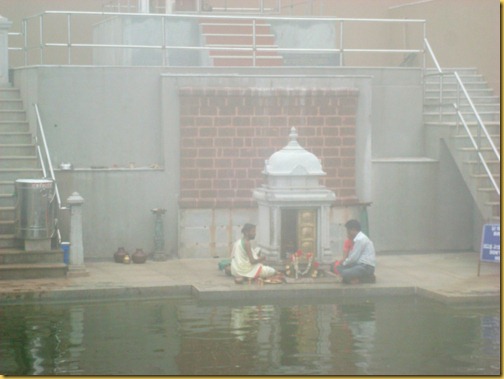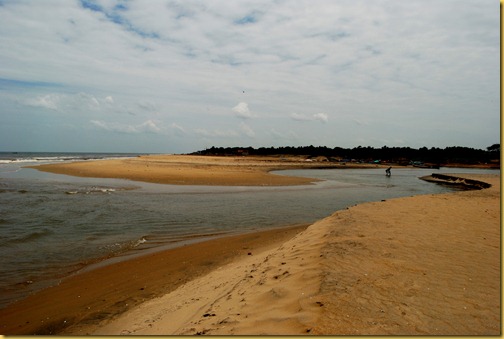One of my dream journeys is to follow the River Cauvery along her course and visit some of the known and unknown towns where she flows and listen to their lores. I have visited a few cities and villages but my favourites are Talacauvery, where the river begins her journey as a little spring and ends as a little stream at Poompuhar where she joins the sea . The origin is in Karnataka and her final destiny ends in Tamil Nadu. It was a misty day when I was in Coorg, but a very warm day in the Poompuhar coast. Personally, I feel that rivers are symbols of freedom as they follow their own course and no one really has any control over them, except maybe the weather Gods. However, some day I hope I will make the journey at one go � all the way from Talacauvery to Poompuhar.
Here are the stories on Talacauvery and Poompuhar that was published in The Hindu, in my column, The Inside Story
Talacauvery
A visit to Coorg is never complete if one does not go to Bhagamandala and Talacauvery, the origin of the river Cauvery. We went to Bhagamandala first which is the confluence or kudla or sangama of the three rivers, Cauvery and its tributaries Kanika andSujyoti . Interestingly Sujyoti is largely mythical as its meant to be flowing underground and joining the main river as she spreads herself and flows along .
Bhagamandala comes from the name Sri Bhagandeshwara temple, which houses the deities Bhagandeshwara (Lord Shiva), Subramanya , Vishnu and Ganapathi . Known as Bhagundeshwara Kshetra .the temples are built in kerala style and each sculpture tells a different story. A customary dip in these waters is said to purge you from all negative influences. An inscription here talks about how Bhagamandala was captured by Tipu Sultan who renamed it as Afesalabad and it was retrieved by Doddaveeraja after a fierce battle which lasted for about a week.
We move on to the Brahmagiri hills to Talacauvery where the river originates and flows down 800 kms down to Poompuhar in Tamil Nadu. .The weather changes as the sun retreats as the mist takes over.The entire mountains are enveloped .
An enclosure around the spring called Gundige is connected to a small pond .which flows underground and emerges after about a kilometer down the hill. There are shrines above the spring and temples dedicated to Agasthyeshwara and Ganesha. It is believed that the Saptha Rishis had performed a penance here to get immortality. The priest inform us that the Agni Kundas can be seen there.
A plethora of legends flow down the Cauvery, but the most interesting that we heard is the legend of the river itself. Cauvery prayed to Lord Vishnu that she should become the most sacred of rivers and Vishnu granted her the wish saying that the while Ganga originates from the Lord�s feet, Cauvery will be worn as a garland by the God. It is believed that Ganga flows underground and even cleanses herself in the Cauvery and remains here for a month .
Pilgrims flock to Talacauvery in mid October where the river gives darshan to her devotees.The water from the spring overflows and it is called Tula Sankramana .It is believed to be the rebirth of the river itself and the priests tell us that Goddess Parvati comes down to earth on that day. The holy water is taken home by all pilgrims after a dip in the river .
We see a lot of trekkers climbing down the Brahmagiri Hills to see the panoramic view of Karnataka and the coast as well. As we prayed to the river, the mist suddenly touched our cheeks and before we knew it, we were wrapped in it .We were lost to the world as a thin white layer took us in its fold and gently lulled us to sleep.
Poompuhar
It is a hot and a humid afternoon and I am hardly surprised with the weather . I have been driving down coastal Tamil Nadu over the last few days and the sun has been rather merciless, with an occasional breeze attempting to lower the temperatures. Fishing hamlets, forgotten ports, erstwhile colonies and temple towns fill my travel diary as I head towards a sea side town, that was believed to have been swallowed by a tsunami several centuries ago.
My destination is a port that finds mention in the ancient Tamil and Buddhist literature and in the works of international travelers and historians like Ptolemy and Pliny. Mystery shrouds this old forgotten port as it is surrounded by legends .Discovering its history is like putting together the pieces of a jig saw puzzle together .The clues are largely the hyperbolic descriptions of the town from ancient poems like Pattinappalai and epics like Silappadikaram , inscriptions from temples and from excavations held under water and on land.
I am referring to the port capital of the Cholas - Puhar or Kaveripoompattinam, known today as Poompuhar, associated largely with the reign of Karaikal Chola and which comes alive in the verses of Pattinappalai , a literary work of the Sangam Age. Images of huge ships docking in the sea bringing in merchandise from distant shores to mansions built by foreign merchants are painted vividly in this poem. The epic, Silappadikaram recreates the ancient town with its markets , mansions, gardens and palaces. The port was called Maruvurpakkam , inhabited by traders, fishermen and foreign merchants while Pattinapakkam , with its palaces and gardens was the home of the royalty.
And yet as you drive through the chaos and clutter of the new town Poompuhar, you can hardly see any trace of the ancient capital We cross the excavations of Pallaveshwaram, where we are told that the ruins of an old Buddhist monastery was said to have been unearthed. The Buddhist literary work, Manimekalai speaks of the Buddhist influence in the town, while records its destruction by a tsunami.
�There is nothing really here, can we go back ? � asks my hungry driver as I tell him to head towards the sea. There is one site that still remains till date . Puhar am told refers to the mouth of the river and the ancient town was apparently located at the estuary of the River Cauvery where it joins the Bay of Bengal. I walk in the heat to see the magical moment.
An old lighthouse watches over the sea . Running parallel to the sea and separated by a patch of black sands is the river Cauvery curving towards the sea . A small stream that gets narrower as it meanders its way to its destination. A couple of fishermen are washing their boats. The sands meanwhile dramatically changes colour from black to almost white as the waves of the sea welcomes the river into its folds . It is a surreal setting . The sea curves and the river arches and they embrace as the waters flow . A small temple overlooks the estuary. An old lady walks away, as a lone fisherman wades through the estuary and crosses over to the shore. � Super stills madam �he says and smiles at me as I photograph the confluence .
It is hard to imagine that the tame sea would have ruthlessly devoured a town centuries ago. It is even harder to imagine the busy port painted by the literary works with merchants, weavers, jewelers ,potters all hosting day and night markets lies somewhere in the ocean depths. As I leave, I take a last look at the river and sea merging quietly, wondering if they have written a watery epitaph for Puhar.





No comments:
Post a Comment